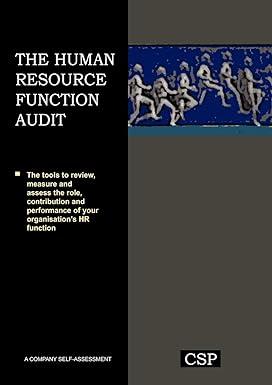Question
Williams Corporation develops and manufactures pharmaceutical drugs. During the calendar and fiscal year ended December 31, 2016, Williams had the following situations that resulted, or
Williams Corporation develops and manufactures pharmaceutical drugs. During the calendar and fiscal year ended December 31, 2016, Williams had the following situations that resulted, or could result in lawsuits. Williams published its 2016 financial statements on February 24, 2017.
1. On October 3, Williams Company sued a competitor for $5,000,000 for patent infringement. Williamss lawyers have deemed that it is probable that Williams will win the lawsuit, but that the award amount will more likely be $3,000,000 instead of $5,000,000. The lawsuit was settled on June 23, 2017 for $3,200,000.
2. On March 10, one of Williamss employees sued the company for $1,000,000, claiming that that he suffered injuries to his respiratory tract as a result of inhaling chemicals from the lab. Williamss lawyers have deemed that the loss is reasonably possible, but that the amount would be $300,000 instead of $1,000,000.
3. On May 6, Williams Company learned that 43 people had fallen ill after using one of their products. Upon further investigation, it was determined that the cause of the illness was an excess dose of one of the compounds used in one of Williamss allergy medications. Williamss lawyers learned that the affected customers intended to file a class-action lawsuit, and determined that the amount of the loss would be between $15,000,000 and $30,000,000. Williams hired a loss analysis specialist company to perform an assessment of their potential loss, and that company determined that the most likely amount of the loss would be $22,000,000.
4. On July 13, Williams received notice that the EPA was issuing fines to any pharmaceutical company that was deemed to be improperly disposing of their chemical waste and polluting nearby rivers. The fines ranged from $1 million, for moderate pollution, to $5,000,000, for severe pollution. Williams had recently performed an extensive audit of their operations and determined that their disposal methods had little-to-no negative impact on the environment.
5. On November 3, one of the pharmaceutical sales representatives for Williams slipped in the lobby of the corporate office and broke her hip, arm and leg. In her accident report, she stated that the lobby floor was excessively slippery, and that this directly contributed to her fall. Williamss lawyers deem that it is probable that she will sue the company and that range of the lawsuit would be between $400,000 and $1,000,000. On May 3, 2017 the employee settled with the company for $650,000.
6. On December 5, one of Williamss laboratory technicians was injured by one of the pressing machines used in the manufacturing process. The employee claimed that there were not sufficient warning signs in place to prevent employees from getting too close to the machines and preventing an accident. On December 19, the employee sued Williams for $2,200,000. Williamss lawyers expected to settle the lawsuit for an amount ranging from $750,000 - $1,000,000. On January 11, 2017, Williams settled with the employee for $800,000.
Required:
For each scenario above, determine whether Williams should accrue the contingency, disclose the contingency or do nothing. If a situation requires an accrual or note disclosure, determine the amount that should be accrued and/or disclosed. If an item does not require an accrual/disclosure, explain why not.
Step by Step Solution
There are 3 Steps involved in it
Step: 1

Get Instant Access to Expert-Tailored Solutions
See step-by-step solutions with expert insights and AI powered tools for academic success
Step: 2

Step: 3

Ace Your Homework with AI
Get the answers you need in no time with our AI-driven, step-by-step assistance
Get Started


